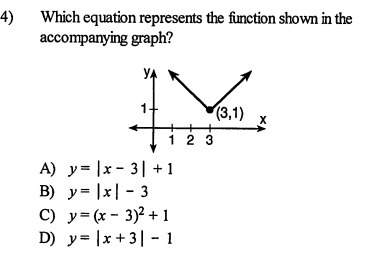The graph of the function f(x) = (x − 3)(x + 1) is shown.
On a coordinate plane, a parab...

Mathematics, 07.03.2020 04:24 thezbell
The graph of the function f(x) = (x − 3)(x + 1) is shown.
On a coordinate plane, a parabola opens up. It goes through (negative 1, 0), has a vertex at (1, negative 4), and goes through (3, 0).
Which describes all of the values for which the graph is positive and decreasing?
all real values of x where x < −1
all real values of x where x < 1
all real values of x where 1 < x < 3
all real values of x where x > 3

Answers: 1
Another question on Mathematics

Mathematics, 21.06.2019 20:50
Samson is going shopping for sugar and butter to make three different kinds of cookies: lemon bars, peanut butter cookies, and sugar cookies. the recipe for lemon bars calls for 2 cups of flour, 2 cups of sugar, and 1 stick of butter. the peanut butter cookie recipe calls for 2 cups of flour, 4 cup of sugar and 2 stick of butter. the sugar cookie recipe calls for 1 cup of flour, 2 cups of sugar, and 2 sticks of butter. sampson has 13 cups of flour at home, and he buys 12 cups (6 pounds) of sugar and 10 sticks of butter. how many batches of each type of cookie can he make? samson can make batches of lemon bars, batches of peanut butter cookies, and batches of 09 cookies submit reset
Answers: 1

Mathematics, 21.06.2019 22:30
Adistribution has the five-number summary shown below. what is the third quartile, q3, of this distribution? 22, 34, 41, 55, 62
Answers: 2


Mathematics, 21.06.2019 23:00
In january 2010, you began a one-year study of tuberculosis (tb) in a subsidized housing community in the lower east side of new york city. you enrolled 500 residents in your study and checked on their tb status on a monthly basis. at the start of your study on january 1st, you screened all 500 residents. upon screening, you found that 30 of the healthy residents had been vaccinated for tb and therefore were not at risk. another 20 residents already had existing cases of tb on january 1st. on february 1st, 5 residents developed tb. on april 1st, 10 more residents developed tb. on june 1st, 10 healthy residents moved away from new york city and were lost to follow-up. on july 1st, 10 of the residents who had existing tb on january 1st died from their disease. the study ended on december 31, 2010. assume that once a person gets tb, they have it for the duration of the study, and assume that all remaining residents stayed healthy and were not lost to follow-up. is the subsidized housing community in the lower east side of new york city a dynamic or fixed population? briefly explain the rationale for your answer. dynamic population it can changeable people can move out and move in into the population of a subsidized housing what was the prevalence of tb in the screened community on january 1st? prevalence = 30/500 0.06= 6% what was the prevalence of tb on june 30th? prevalence= 40/450=0.08= 8.88% what was the cumulative incidence of tb over the year? cumulative incidence = number of new cases/number in candidate population)over specified time period 10/450 = 2.2% suppose that you wanted to calculate the incidence rate of tb in the study population. calculate the amount of person-time that would go in the denominator of this incidence rate. be sure to show your work.
Answers: 2
You know the right answer?
Questions

Mathematics, 18.03.2021 03:10


History, 18.03.2021 03:10





History, 18.03.2021 03:10



Mathematics, 18.03.2021 03:10








Arts, 18.03.2021 03:10

Physics, 18.03.2021 03:10




